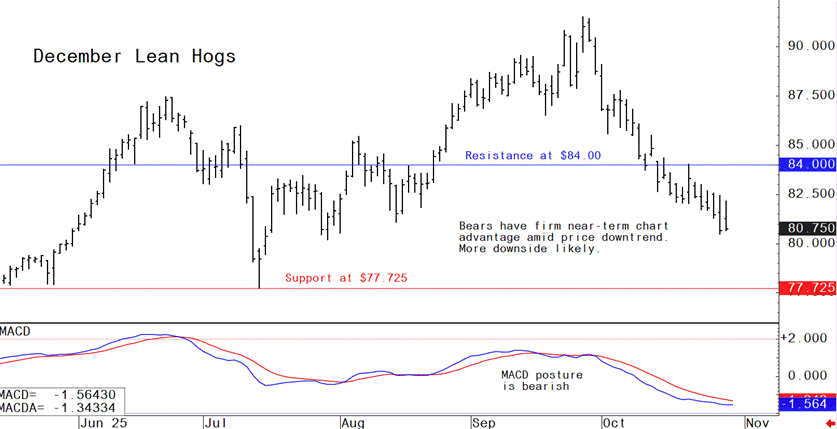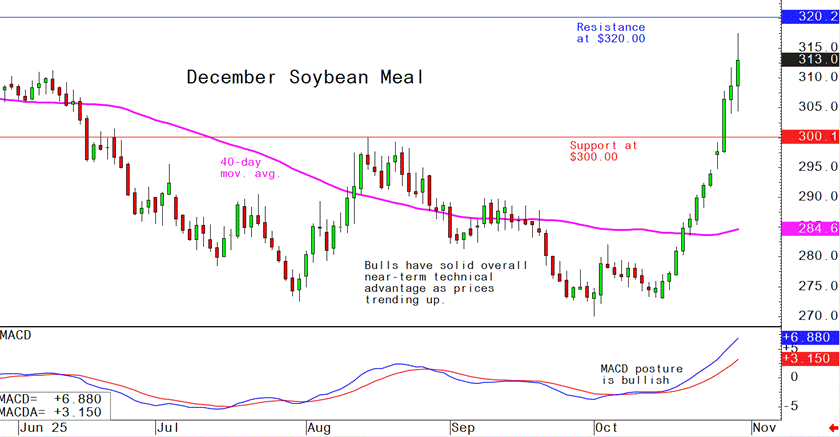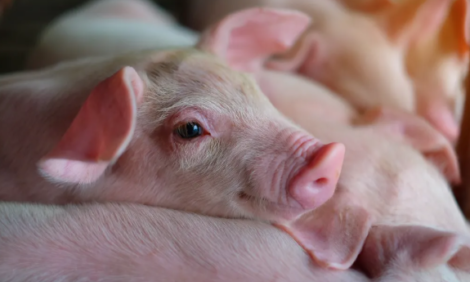



Pig outlook: Lean hog futures bears still in control
Livestock analyst Jim Wyckoff reports on global pig news
Lean hog futures market bulls are working to stabilize prices. Price action in hog futures paused Wednesday following the recent selling pressure that saw lower closes in December futures for five sessions in a row. Firmly bearish technicals and steadily declining cash hog prices are limiting buying interest in the hog futures market. December lean hog futures’ discount to the cash index has somewhat limited selling interest in futures recently. The latest CME lean hog index is down another 24 cents at $92.03. Today’s projected cash hog index is down another 17 cents at $91.86. Wednesday’s national direct 5-day rolling average cash hog price quote was $87.90.
U.S. Senate Finance Panel Grills USTR Nominee on Potatoes & Meat
Dr. Julie Callahan, President Trump’s nominee to serve as Chief Agricultural Negotiator at the Office of the U.S. Trade Representative, faced pointed questions from senators about the administration’s trade strategy with Argentina during a contentious Senate Finance Committee hearing on Oct. 29. The scope of the hearing provided a full view of U.S. agricultural trade priorities under the Trump administration’s reciprocal-trade framework.
Sen. Ted Cruz (R-Tex.) and Sen. John Barrasso (R-Wyo.) both raised concerns about the administration’s plan to increase Argentine beef imports under an expanded tariff-rate quota (TRQ). Cruz said there was “unanimity in the room that we should be standing strongly with our cattle ranchers.” Barrasso pressed Callahan on the timing and size of the planned 80 000-ton TRQ increase and asked how she would ensure that “U.S. ranchers aren’t undercut by lower-standard imports.”
In response to Barrasso’s questions, she said the talks with Argentina are “ongoing” and that her goal is to “reverse the U.S. agricultural trade deficit” through agreements on reciprocal trade that would turn deficits into surpluses and “ensure that U.S. cattlemen have access to markets around the world.” This phrasing — specifically her emphasis on reciprocal trade and reversing the deficit — clearly reflects a U.S. intent to obtain concessions from Argentina in exchange for expanded access.
Daines devoted a significant portion of his questioning to the collapse in U.S. beef exports to China since March. Daines said that foreign competitors — notably Australia and Brazil — were “filling the void” left by reduced U.S. shipments. He asked: “Dr. Callahan, are we making any progress in reopening the China market, the second-largest beef export market in the world, or finding additional markets for U.S. beef?”
Callahan’s response: She acknowledged the sharp decline and said, “If confirmed, I am committed to reopening China’s market to U.S. beef. China’s behavior can be explained only with one word — retaliation.”
She added that during President Trump’s first term, USTR provided the White House with weekly reports on China’s compliance under the Phase One trade deal and that she intends to “reverse that trend and rebuild access to the Chinese market.”
Support from Republicans and Industry Concerns
Republican senators largely backed Callahan’s broader trade philosophy but sought assurances that Argentine imports would not depress domestic cattle prices. Sen. Barrasso cited ranchers’ fears of an “announcement related to Argentina” and asked how she would protect U.S. producers. Callahan replied that all current negotiations “are intended to reverse the U.S. agricultural trade deficit” and to ensure “U.S. cattlemen have access to markets around the world.” She said the Argentina beef talks remain “ongoing” and without a fixed timeline.
Barrasso also questioned her about the struggling U.S. sheep industry. Callahan said she had met with Utah producers and was “committed to ensuring that American lamb producers have a fair shake,” adding that imports were “out-competing” domestic growers and that she aimed “to see that reversed.”
Broader Meat Trade and Market Access
In her opening statement, Callahan grouped beef, pork, and poultry together when outlining her trade priorities, noting that U.S. meat exports face a mix of tariff and sanitary-phytosanitary barriers. She said she would work to:
• eliminate “unjustified restrictions on U.S. meat,”
• press for science-based import protocols, and
• expand access in markets such as Japan, South Korea, and Southeast Asia.
U.S. pork group urges FDA to reconsider ‘ultra-processed’ label ahead of dietary guidelines
Pork producers call for a nutrition-focused framework to guide food labeling and protect consumer access to safe, nutrient-rich products.
As the Food and Drug Administration prepares its formal definition of “ultra-processed foods” in advance of the new Dietary Guidelines for Americans, the National Pork Producers Council (NPPC) is urging the agency to take a more balanced, science-based approach that focuses on nutritional value rather than manufacturing methods.
In a statement submitted to the Trump administration and FDA, NPPC warned that an overly broad or poorly defined “ultra-processed” category could unfairly stigmatize pork products and other safe, nutrient-dense foods. The group called on FDA to avoid relying on the controversial NOVA classification system, which categorizes foods based primarily on how they are processed rather than their health benefits.
Foods should not be labeled “ultra-processed” simply because they include ingredients that enhance food safety, shelf stability, or nutrient availability, NPPC emphasized — all of which protect public health and ensure high-quality protein reaches consumers. The group also urged FDA to ensure any definition aligns with the agency’s existing Standards of Identity, which govern what specific foods must contain and how they are formulated.
Given the lack of consensus on what constitutes “ultra-processed,” NPPC encouraged FDA to “elevate the importance of nutritional composition” and avoid penalizing safe food processing techniques. As an alternative, NPPC proposed using the term “discretionary foods” to describe items of lower nutritional quality — a framework that would refocus dietary policy on nutrition rather than processing labels.
NPPC: Trump opens Malaysian market to US pork exports
Trade deal hailed by pork producers as a major win for American agriculture and rural jobs
President Donald Trump has signed new trade agreements with Malaysia and Cambodia, marking a significant victory for U.S. pork producers. The Malaysia deal, in particular, offers enormous potential for America’s more than 60,000 pork producers by eliminating export barriers and expanding market access. “America’s pork producers are grateful to President Trump for increasing market access for U.S. pork to Malaysia,” said NPPC President Duane Stateler, a pork producer from Ohio. “More than 25% of U.S. pork production is exported, so producers count on exports to help keep their farms afloat, especially in times of uncertainty.”
Under the agreement, all U.S. facilities listed in the FSIS Meat, Poultry and Egg Product Inspection Directory will be eligible to export to Malaysia without additional registration requirements. The country also agreed to accept standard FSIS export certificates and, within 15 months, recognize the U.S. African Swine Fever protection zone to complete a regionalization deal. Cambodia signed on to similar terms.
NPPC credited USTR Ambassador Jamieson Greer, Assistant USTR Julie Callahan, and USDA technical teams for facilitating the breakthrough.
U.S. pork exports to Malaysia reached $24.5 million in 2024, up 1,700% over the past five years, despite only eight U.S. plants being eligible for export. The sector supports over 140,000 American jobs and adds $66 in export value per hog marketed.
NPPC emphasized pork producers rely on trade stability: “American pork producers need certainty and stability — now as much as ever — and NPPC will continue to engage with the administration and international partners to maintain and open new market access for U.S. pork.”
The next week’s likely high-low price trading ranges:
- December lean hog futures--$78.00 to $84.00 and with a sideways-lower bias
- December soybean meal futures--$300.00 to $320.00, and with a sideways-higher bias
- December corn futures--$4.20 to $4.40 and a sideways-higher bias
Latest analytical daily charts lean hog, soybean meal and corn futures












